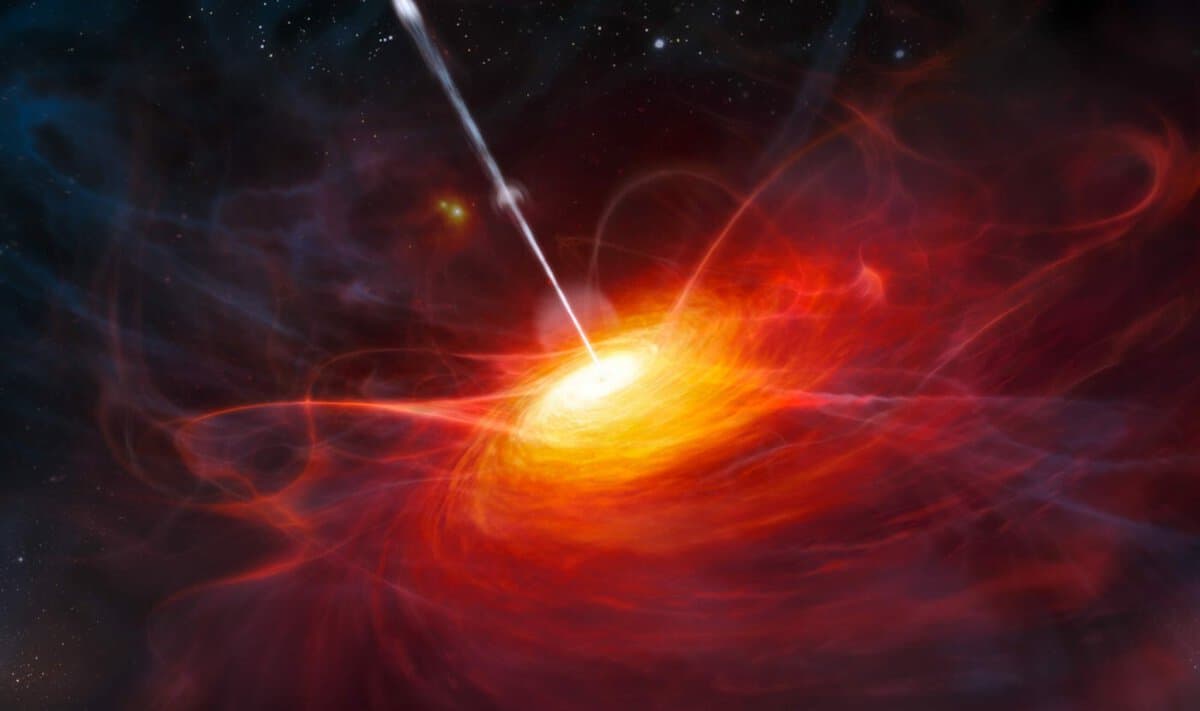
The future of astronomy is set to be revolutionized by the James Webb telescope. In just its initial month of operation, it has already surpassed all expectations. With its impressive system of 18 hexagonal mirrors coated in gold, this telescope has the ability to peer further into the depths of the universe than any of its predecessors. Among the vast expanse captured in one of its earliest images was a seemingly ordinary red dot. However, upon closer examination, it was revealed to be one of the most remote and thus ancient galaxies ever documented.
The GLASS-z13 galaxy was observed by the “James Webb” telescope and is estimated to have existed approximately 13.5 billion years ago, when the Universe was only 350 million years old. This discovery makes GLASS-z13 about 100 million years older than GN-z11, which was previously considered the oldest known galaxy by astronomers.
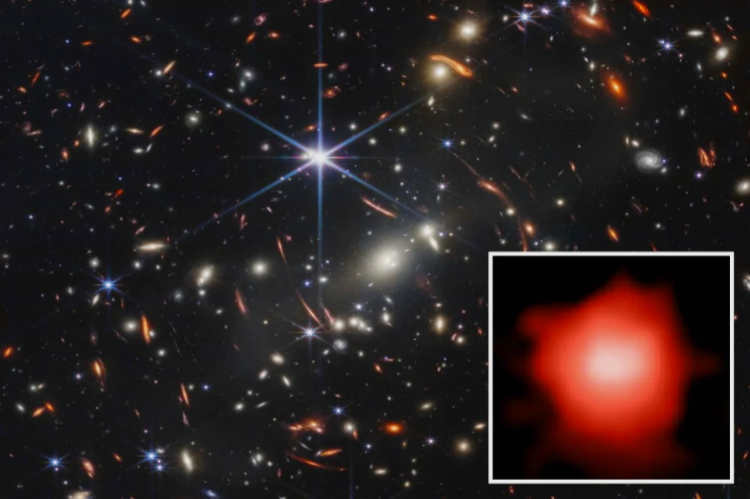
Hottest phenomenon in outer space: quasar 3 °C 273
Located at the core of numerous youthful galaxies are some of the most luminous occurrences in the cosmos: quasars. They emit such a tremendous amount of energy that they frequently outshine all the stars in their galaxy combined by a factor of 100. Due to their immense distance from Earth, we perceive them as they existed during the initial formation of the Universe.
The Boomerang Nebula: the coldest spot in the universe
Relic research is the remaining study of the thermal radiation that originated from the Big Bang and still fills the Universe in a nearly uniform manner. As a result, the temperature of the cosmos rarely goes below -270 o C. Nevertheless, there are certain exceptions.
About 5,000 light-years away from Earth lies the young planetary nebula known as the Boomerang Nebula. Astronomers made the remarkable discovery in 1995 that the temperature in this part of space is only 1 K, or nearly -272.15 o C. Absolute zero (0 K or -273.15 o C) is the theoretical lowest achievable temperature at which all molecular and atomic activity ceases.
The gas expelled by the dying star at its core comprises the Boomerang Nebula. The prevailing scientific consensus suggests that it is propelled in a circular motion by winds that can reach speeds of 500,000 kilometers per hour. This phenomenon is responsible for the creation of extremely low temperatures within the nebula.
PSR J1748-2446ad: The Swiftest Rotating Star
PSR J1748-2446ad is a deceased star situated approximately 18 thousand light-years away from our planet. Its surface at the equator spins at a staggering rate of roughly 250 million kilometers per hour. This equates to approximately 24% of the speed of light.
Similar to every other neutron star, PSR J1748-2446ad came into existence when a massive star depleted its nuclear fuel and ceased to counteract the force of gravity. When a star of this magnitude perishes, its core contracts from the dimensions of the Sun to a structure roughly the size of a city. This transformation gives rise to an extraordinarily dense form of matter that is rich in neutrons, with a mere tablespoon of it weighing a staggering 1 billion tons. Additionally, it causes certain stars, such as PSR J1748-2446ad, to rotate at astonishing velocities.
The lightest planets: Kepler-51’s superpuffs
Superpuffs, also known as Kepler-51b, Kepler-51c, and Kepler-51d, are a group of planets with masses similar to or slightly greater than Earth’s. However, their densities are incredibly low due to their highly inflated atmospheres. In fact, these planets are the least dense ones ever found. They resemble giant cotton candy balls, similar in size to Jupiter. Another fascinating fact is that all three of these superpuffs orbit the same star, Kepler-51.
The discovery of something extraordinary is what makes science so fascinating. Scientists often spend years, or even centuries, trying to comprehend these unusual phenomena. This was certainly the case with the quasar.
In the 1960s, astronomers using Earth-based telescopes encountered a perplexing mystery. They were detecting radio waves emanating from the Sun, the galaxy, and some stars, but they also came across unfamiliar sources that had never been observed before. These sources were incredibly small, yet astonishingly bright.
These peculiar objects were named quasi-stellar objects (quasars), but this label did not provide an explanation for their nature or origin. Initially, scientists could only determine that quasars were moving away from us at a speed equivalent to one-third the speed of light.
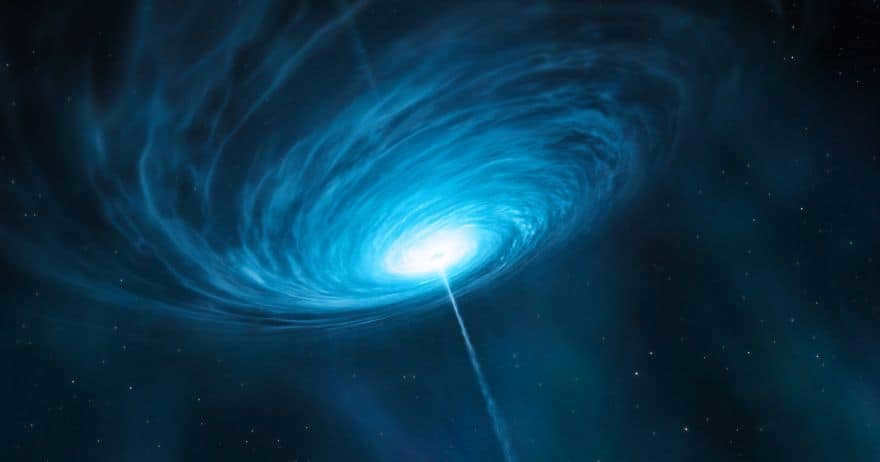
Quasars are fascinating entities due to their ability to overshadow entire galaxies with their brilliant luminosity. These celestial formations, powered by black holes, are immensely larger than the Sun, with a mass billions of times greater.


This image shows a quasar similar to APM 08279+5255, where scientists have discovered vast amounts of water vapor. It is believed that a cluster of gas and dust is forming a protrusion around the central area.
Scientists were astounded by the initial data they received on the amount of incoming energy. The existence of such objects was hard to believe for many individuals. This skepticism prompted them to search for alternative explanations for what was unfolding. Some speculated that the redshift did not indicate distance and instead had another cause. However, subsequent research dismissed these alternative theories, forcing them to acknowledge that we are indeed witnessing some of the most brilliant and awe-inspiring celestial bodies.
This study originated in the 1930s when Carl Jansky discovered that statistical interference in transatlantic telephone lines was originating from the Milky Way. In the 1950s, scientists utilized radio telescopes to observe the sky and correlated those findings with visible observations.
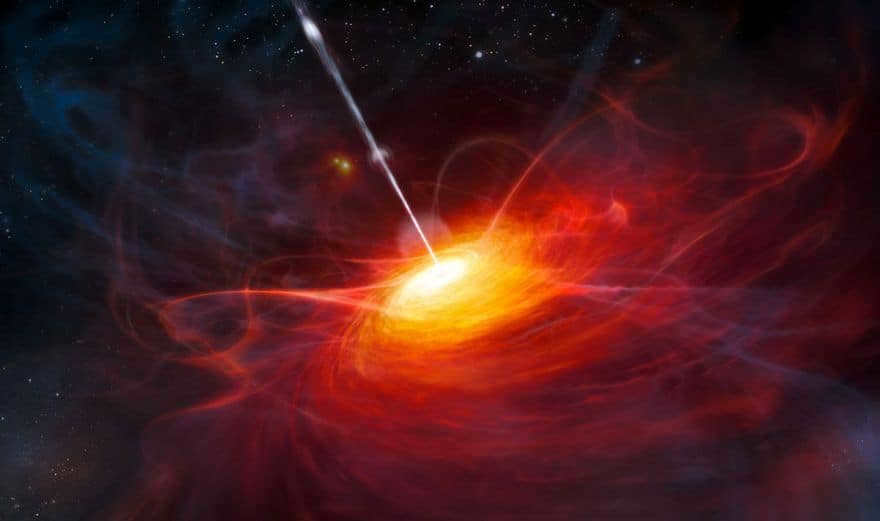
There is an illustration depicting a quasar and a black hole similar to APM 08279+5255, where scientists have observed a significant amount of water vapor. It is believed that dust and gas combine to form a torus around the black hole.
Surrounding the black hole is a massive gas cloud that swirls around it. Once the gas enters the black hole, its temperature rises to millions of degrees, resulting in the emission of thermal radiation. As a result, the quasar shines brightly not only in the visible spectrum but also in X-rays.
However, there is a limit known as the Eddington limit, which depends on the mass of the black hole. When a large amount of gas enters, it creates immense pressure, slowing down the gas flow and keeping the quasar’s brightness below the Eddington line.
It is important to note that all quasars are located far away from us, with the closest one being 800 million light years away. Therefore, one could argue that there are no quasars left in the modern Universe.
What happened to them? The precise details are unknown. However, it is probable that the depletion of the fuel supply is the cause, judging by the power source. The gas and dust in the disk were exhausted, resulting in the quasars losing their ability to emit light.
Quasars – Remote Illumination
If we are discussing a quasar, it is essential to clarify the definition of a pulsar. It is a neutron star that rotates rapidly. It forms during the collapse of a supernova, when a highly compressed core remains. It is encompassed by an immensely powerful magnetic field (exceeding that of the Earth by a trillion-fold), which leads to the emission of detectable radio waves and radioactive particles from its poles. These objects emit various forms of radiation.
Gamma-ray pulsars emit powerful gamma rays. When the neutron star rotates towards us, we observe radio waves whenever one of its poles is directed towards us. This phenomenon is similar to the beam of light from a lighthouse. The intensity of the pulsar’s light varies depending on its size and mass. Occasionally, a pulsar can have a binary companion, which it can accrete matter from and enhance its rotation. In some cases, the pulsar can pulsate up to 100 times per second.
What is a quasar?
There is currently no precise definition for a quasar. However, recent evidence suggests that quasars could be formed by supermassive black holes that absorb matter in an accretion disk. As the black hole’s rotation speeds up, it becomes hotter. When particles collide, they generate a significant amount of light and release it as other forms of radiation, such as X-rays. In this state, the black hole can consume matter equivalent to the volume of the Sun in a year. At the same time, a substantial amount of energy is expelled from the north and south poles of the black hole, creating what is known as cosmic jets.
Alternatively, some scientists propose that quasars might actually be young galaxies. Since very little is known about these objects, the quasar could represent an early stage of ejected energy. Another theory suggests that quasars could be distant points in space where new matter enters the Universe.
The quest for quasars
Quasars were first discovered with the identification of 3C 273, located in the Virgo constellation, in 1960 by T. Matthews and A. Sandidge. Initially, it was classified as the 16th star-like object. However, after three years, it was observed to have a significant redshift, indicating something peculiar about its nature. Scientists soon realized that the intense energy emitted by quasars originated from a compact region, leading to groundbreaking insights.

The constellation Virgo is home to the famous Quasar 3C 273.
Thanks to the phenomenon of redshift, astronomers have been able to discover and identify quasars. When an object is observed to have a high redshift value, it is added to the growing list of known quasars. To date, there are over 2,000 quasars that have been identified. The Hubble Space Telescope plays a pivotal role in the search and study of these enigmatic cosmic objects. With continued advancements in technology, we are gradually unraveling the secrets and mysteries behind these fascinating universal lights.
Quasars and the Phenomenon of Light Jets
Researchers propose that the minute flashes observed are indications originating from the core of galaxies, which surpass the brightness of entire galactic systems. Exclusive to galaxies housing supermassive black holes, weighing in at a staggering one billion times the mass of our sun, these powerful celestial entities are known as quasars. Despite the inability of light to escape these enigmatic locations, certain particles manage to navigate the periphery. As dust and gas succumb to the gravitational pull, other particles are propelled away at velocities approaching that of light itself.
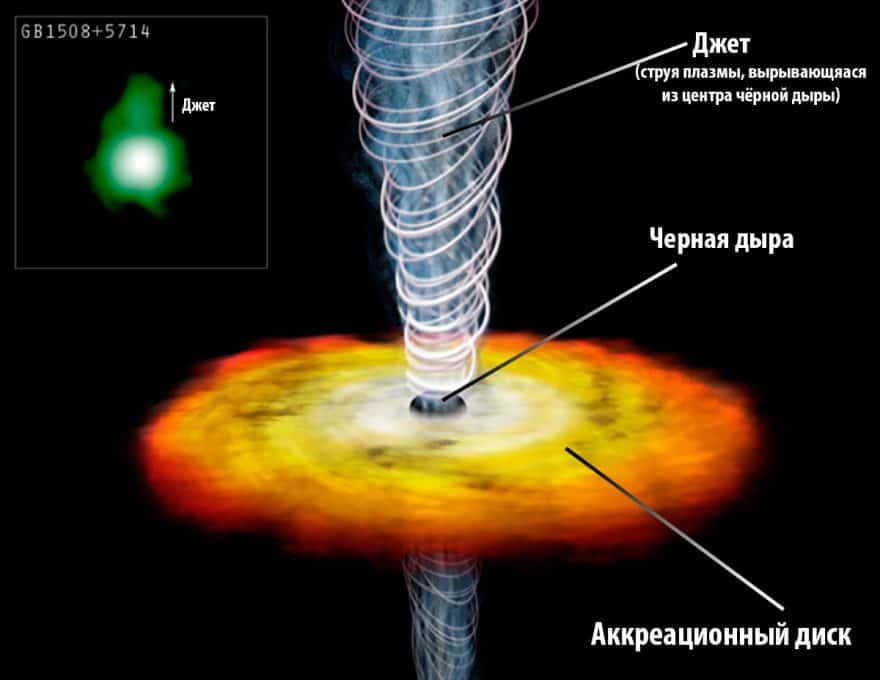
The majority of quasars in the cosmos have been discovered at distances of billions of light years. It’s important to keep in mind that light requires time to reach us, so studying these objects is like peering into the past. Many of the 2,000 quasars that have been identified existed during the early stages of galactic development. Quasars possess the ability to generate energy equivalent to a trillion electron volts, surpassing the combined light output of all the stars in our galaxy (outshining the luminosity of the Milky Way by a factor of 10-100,000).
Categories of quasars
Quasars belong to the group of “active galactic nuclei”. Other examples within this category include Seyfert galaxies and blazars. All of these objects require a supermassive black hole to provide the necessary energy.

Seyfert galaxies have lower energy levels, producing only 100 keV. Blazars, on the other hand, consume a much larger amount of energy. While many scientists speculate that these three types of objects are actually the same, just observed from different angles, there are some differences. Quasar jets are observed at an angle towards Earth, a characteristic that blazars also possess. However, the jets from Seyfert galaxies are not visible, leading to the suggestion that their emissions are not directed towards us and therefore go unnoticed.
Quasars reveal the early formation of galaxies
By studying the oldest objects in the universe, researchers can gain insights into the appearance of the Milky Way during its early stages.
The Atacama Large Millimeter Array has the capability to observe galaxies similar to ours in their “infant” state, providing a snapshot of the moment when stars were just beginning to form. This is truly remarkable as it allows us to peer back in time to a period when the universe was a mere 2 billion years old.
Through observations of two ancient galaxies in infrared wavelengths, scientists have made an intriguing discovery. They have observed elongated disks of hydrogen gas, which outnumber the smaller inner regions where star formation occurs. These galaxies also possess rotating disks of gas and dust, with stars forming at a relatively rapid rate of 100 solar masses per year.
The objects under investigation are ALMA J081740.86+135138.2 and ALMA J120110.26+211756.2. The observations were assisted by quasars, which emitted light from the background. We are referring to supermassive black holes, which have luminous accretion disks concentrated around them. It is theorized that these disks serve as the nuclei of active galaxies.


A quasar positioned at a distance of 12.5 billion light-years is emitting light in the vicinity of a recently formed galaxy, which is situated 12 billion light-years away. The ALMA instruments have been able to capture the presence of ionized carbon (green) and a disk where stars are currently being formed (blue)
Researchers have made an interesting observation regarding the luminous carbon – it appears to be displaced in relation to the hydrogen gas. This discovery suggests that the galactic gases are moving far away from the carbon location, indicating the presence of a significant hydrogen halo surrounding each galaxy.
During the examination of the foreground objects, the scientists initially anticipated detecting a subtle emission above the quasar. However, they were surprised to discover two highly luminous galaxies situated at a considerable distance from the quasar.
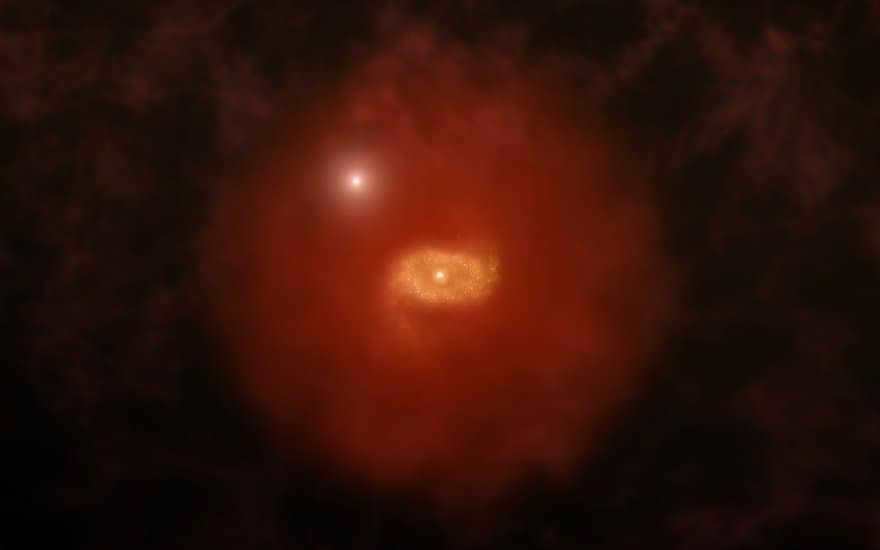
An artistic representation of a galaxy resembling the Milky Way, but smaller in size, showcasing a vibrant quasar emitting a luminous glow in hydrogen gas.
The analysis also validated that these young galaxies have already initiated the process of rotation, which serves as an indication of their classification as spiral galaxies. This venture commenced in 2003, during the embryonic stage of the concept of utilizing quasar spectra to identify foreground galaxies. This mechanism is known as a damped Lyman-alpha system, denoting that the presence of hydrogen gas obstructs the determination of the quasar’s light wavelengths.
ALMA has provided crucial insights into the process of galaxy formation, revealing that some of the early galaxies possessed unexpectedly large halos. These halos may have played a significant role in the growth of these galaxies.
Let’s take a journey back to the 1930s, when a pioneering figure in astronomy, American physicist and astronomer Carl Jansky, made a fascinating discovery. Jansky found that the interference observed in transatlantic telephone lines was actually emanating from our very own Milky Way galaxy. This groundbreaking revelation left the scientific community astounded. However, it wasn’t until the 1950s that astronomers started utilizing radio telescopes to survey the celestial sphere and compare their findings with visible light images.
And the findings left everyone astonished. It was revealed that certain sources of radiation in the radio frequency range had no corresponding counterpart in the visible spectrum. In other words, the scientists stumbled upon a source of radiation emitting radio signals. However, they were unable to identify any star or celestial object in the images that could account for this energy. These enigmatic entities were dubbed “quasi-stellar radio sources” by astronomers. Or simply “quasars.”
The velocity of light
In the realm of science, a logical inquiry arose – what mechanisms give rise to such celestial entities? What colossal forces possess the capability to generate an immense amount of energy? This query necessitated an urgent resolution. Certain scholars even initiated fundraising efforts in order to finance a space mission to explore the nearest quasar and unravel the enigma surrounding it. However, meticulous calculations revealed that such a journey would span a vast duration. Additionally, the world’s supply of stew would not suffice to provision the rocket. This is due to the fact that the closest quasar to Earth is situated approximately 600 million light years away! Consequently, it was determined that a remote investigation into the nature of the quasar was the most viable course of action.
We highly recommend perusing our guide on How to locate the Pleiades star cluster in the night sky?
The immense magnetic field surrounding a black hole propels beams of energy in opposite directions into space, hurtling across the cosmos at incredible speeds….
How far are these beams from us?
Each quasar emits an astronomical amount of energy, surpassing the combined brightness of all the stars in any given galaxy. Quasars rank as the most luminous entities in the Universe. However, they are not the sole members of this category. In fact, quasars belong to a larger family of celestial bodies known as active galactic nuclei, which also encompasses Seyfert galaxies and blazars.
The majority of the quasars discovered in outer space are situated billions of light years away from our planet. As a result, even if these emissions were to travel at the speed of light, it would still take an extremely long period of time for them to reach us. However, there is a positive aspect to this situation. By analyzing these signals, we are able to utilize them as a form of time travel, allowing us to observe celestial bodies as they appeared millions of years ago.
Check out Earth’s incredible voyage throughout the Universe
It has been established that the majority of the 2,000+ quasars that have been discovered emerged during the early stages of their respective galaxies’ development. It is highly plausible that the Milky Way also had a similar object at one point. However, for unknown reasons, it eventually became dormant. If this were not the case, life on Earth would likely be impossible.
Radiation characteristics of radio galaxies and quasars
The identification of novel entities dates back to 1960 – during this time, Thomas Matthews and Allan Sandidge made the groundbreaking discovery of a particular astronomical entity, which was subsequently designated as 3C 48. Subsequent investigation of these discoveries by Martin Schmidt led the scientist to the realization that these objects do not resemble stars, as they are located at a considerable distance from Earth – stars at such distances should not be observable to observers.
At first, quasars were thought to be stars because they are both visible celestial objects. However, further analysis of their electromagnetic radiation revealed that these alleged stars emit an excessive amount of luminescence for their distance. Astronomers then looked at the features of radiation from radio galaxies, which have extremely powerful radio emissions in the electromagnetic spectrum. Based on this, they hypothesized that the detected objects should be associated not with stars, but with radio galaxies, as quasars are just as powerful in terms of radio emission.
Distinctive Traits
Quasars possess unique characteristics as active cores within galaxies, emitting enormous amounts of energy. This accounts for the extraordinary intensity of radiation they emit into the vast expanse of space. In terms of luminosity, a quasar surpasses an entire galactic system, dwarfing the energy released from a supernova explosion in just thirty minutes. Despite containing billions of stars, galaxies pale in comparison to the compact size of quasars, which are roughly the size of our solar system.
One notable trait of quasar radiation is its ability to be observed from billions of light years away, a characteristic shared with radio galaxies, which can sometimes make their detection more challenging.
The concept of quasars is closely linked to the concept of black holes. These two entities are directly connected and their relationship helps to explain the unique characteristics of both. In the field of astronomy, it is widely accepted that the quasar model includes a supermassive black hole that draws in and consumes the surrounding galactic space, which is filled with stars.
As matter is pulled towards the black hole, it begins to spiral and forms an accretion disk. The radiation emitted from this disk is often mistaken for starlight. Additionally, some of the matter that is absorbed by the black hole is ejected along the poles, creating powerful jets that emit radio waves. These jets can extend all the way into the infrared spectrum.
Quasar Hunger
As per one hypothesis, quasars are youthful galaxies that have recently come into existence, in terms of stellar timeframes. At the core of these galaxies lies a black hole, voraciously consuming matter. This is the source of their brilliant radiance. More accurately, the radiance emanates not from the black hole itself, but from the adjacent vicinity. This is due to the fact that the interstellar gas surrounding the black hole is perpetually in an agitated state.
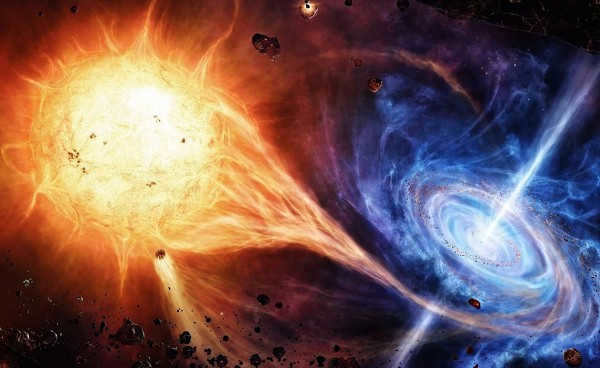
A quasar devours a star
Quasars are not mere black holes, but rather supermassive ones, which accounts for their incredibly powerful radiation. The variations in their brightness can be explained as follows: when a new object enters the gravitational pull of the black hole, it ignites and brightens. When there is no more matter to consume, its light fades. It should be noted that quasars have an insatiable appetite – they consume not only stars, but also their systems, clusters, and even entire galaxies. Eventually, the black hole will devour all the matter within its reach and cease to emit light. This is likely what has happened to the black hole at the center of our galaxy. It has consumed everything within its grasp and is now in a state of rest.
According to an alternative viewpoint, quasars do not constitute black holes in and of themselves, but rather form part of a complex system involving a black hole, a quasar, and a connecting tunnel. The black hole absorbs objects, which subsequently results in the expulsion of absorbed energy through the quasar.
Another intriguing hypothesis posits that quasars represent unique entities within the expanse of the Universe, serving as sites where new energy and matter are generated and subsequently dispersed throughout. In essence, quasars function as cosmic powerhouses reinvigorating the entire Universe.
Astronomers continually make new discoveries of quasars, thanks to the ever-advancing capabilities of telescopes. Presently, over 200,000 quasars have already been identified.
The process of absorption
Once matter is present around a black hole, the black hole immediately begins to emit energy by absorbing the matter. In the early stages, when the first galaxies formed, there was an abundance of matter around black holes, which served as their source of “nourishment”, causing black holes to emit intense light – giving rise to quasars! Interestingly, the amount of energy emitted by an average quasar per second would be sufficient to power the Earth for billions of years. Furthermore, an extraordinary galaxy known as S50014+81 emits light that is 60 thousand times more intense than our Milky Way, which contains a staggering hundred billion stars!
Nevertheless, in the present era, when galaxy collisions are infrequent, it is improbable for quasars to form. It seems that this statement holds true – nearly all detected quasars are located at considerable distances, indicating that the light emitted from them originated in the distant past, during the formation of the initial galaxies. This is the reason why quasars are occasionally referred to as the “dinosaurs of the Universe”, as it not only highlights their remarkably ancient age but also implies that they are metaphorically “extinct”.
What is the lifespan of quasars?
Quasars, which are powered by supermassive black holes, do not have an infinite lifespan. Once the black hole exhausts its supply of material, the accretion disk disappears and there is no more energy to be ejected. This marks the end of the quasar’s activity. Thank you, everyone, for your attention. You are now free to leave.
However, it is important to note that the quasar’s activity may resume if new matter approaches the black hole. It is unlikely that this will happen in our galaxy, or at least not for the next few million years…
For more information, you can read about the New Evidence for Late Heavy Bombardment.
All is calm in the Milky Way
Scientific data derived from observations of quasars provides scientists with the evidence to suggest that every galaxy possesses a dormant black hole at its center, which has completed its active phase and is now in a state of slumber due to lack of sustenance.
This theory also applies to the Milky Way, which once resembled a quasar but has since transitioned into a state of rest. This is because the surrounding space near the central black hole no longer contains a sufficient amount of gas and dust to fuel the creation of a luminous accretion disk. Nevertheless, astronomers propose that a quasar could still potentially emerge within our galaxy, but only after the Milky Way collides with the Andromeda galaxy, an event predicted to occur in approximately 4.5 billion years.
Unusual radio formations
While conducting their research, the team of scientists conducted a calibration of the ALMA radio telescope located in Chile. The purpose of this calibration was to distinguish the intense radiance emitted by quasar 3C 273 from the light emitted by its host galaxy. As a result, only the radio waves emitted by the galaxy of the quasar were isolated, thus revealing two massive and enigmatic radio structures that had never been observed before.
One of these structures is a vast expanse of radio emissions that surrounds the entire galaxy and extends for tens of thousands of light-years in the southwest direction. This radio haze coincides with another structure, a colossal jet of energy called the astrophysical jet, which also extends for tens of thousands of light-years.
Furthermore, recent discoveries have indicated the presence of newly formed jets in distant galaxies.
Scientists have yet to fully understand the mechanisms behind the formation of astrophysical jets. However, it is widely observed that jets are commonly found around quasars and other supermassive black holes, and they are believed to be the result of interactions between the black hole and its dusty accretion disk. These jets are typically composed of ionized matter and travel at speeds close to that of light.
The emitted radiation from these jets can vary in brightness depending on the frequency at which it is observed. However, the researchers discovered that the large radio structure surrounding galaxy 3C 273 maintained the same level of brightness across different frequencies. This finding suggests that the two radio structures were formed by distinct and unrelated phenomena.
After conducting various experiments, the team reached the conclusion that the significant “radio fog” surrounding the galaxy originates from hydrogen gas that is involved in the formation of stars and is directly ionized by the quasar itself. The researchers believe that this is the first instance where ionized gas has been observed to extend thousands of light-years around a supermassive black hole.
This discovery addresses a longstanding enigma in the field of astronomy: can a quasar ionize such a large amount of gas in its host galaxy that it inhibits the formation of new stars? To tackle this question, the researchers compared the estimated gas mass of the galaxy with that of other galaxies of similar type and size.
It was discovered that although the quasar ionized an incredibly large quantity of gas, making it unable to create new stars, the overall galaxy still showed clear signs of star formation. This indicates that there may still be thriving, growing galaxies with radiation-emitting quasars at their cores.
“In analyzing other quasars using the same method, we aim to gain insight into how a galaxy evolves through its interactions with the central nucleus,” the researchers stated in their published study.
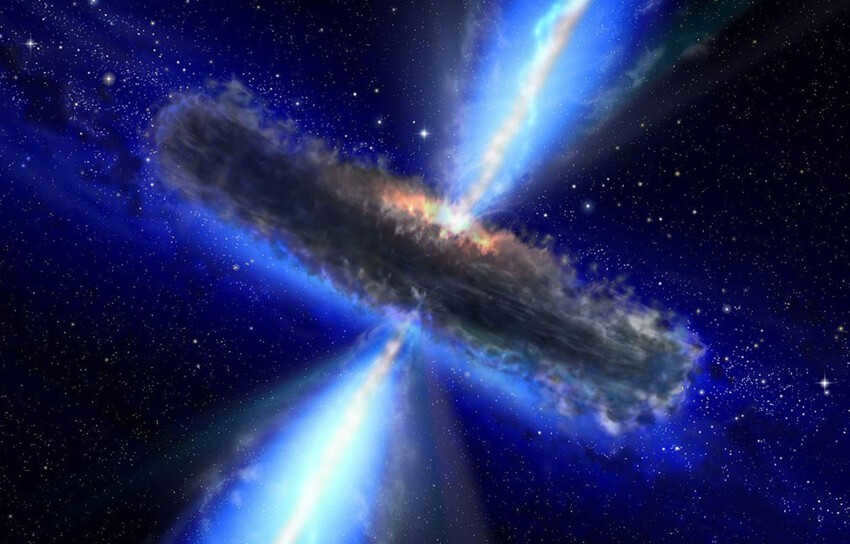
One possible explanation for the observed properties of a quasar is as follows: at the center of a rotating gas disk, there exists a massive compact object, most likely a black hole. This central region emits electromagnetic radiation and high-energy cosmic particles, which can only travel along the axis of the disk. As a result, they form two opposing “arms”.
An energy source
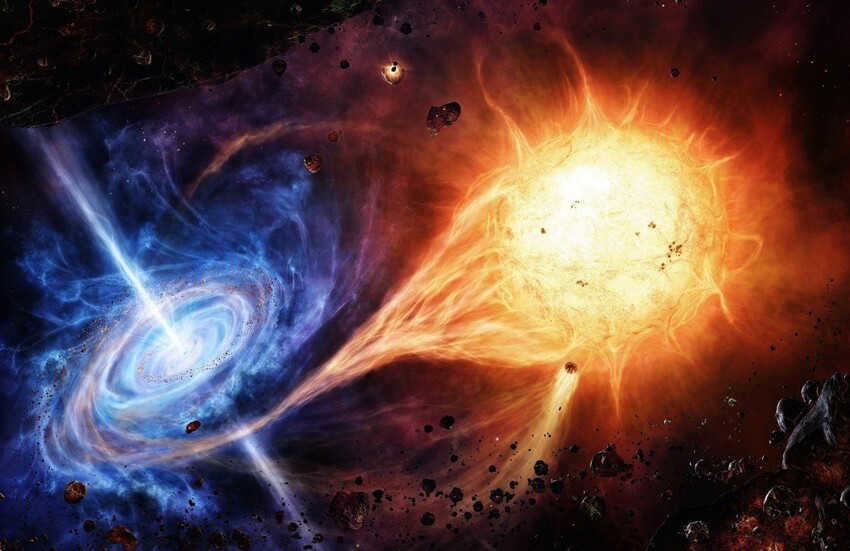
- https://alivespace.ru/kvazar-dalekij-mayak-vselennoj/
- https://24smi.org/facts/269822-chto-takoe-kvazary-evoliutsiia-galaktik.html
- https://SiteKid.ru/astronomiya/kvazary_samye_yarkie_vo_vselennoj.html
- https://www.VokrugSveta.ru/vs/article/411/
- https://www.techinsider.ru/science/1546239-yarchayshaya-chernaya-dyra-vo-vselennoy-sozdala-dva-zagadochnyh-obekta-o-prirode-kotoryh-uchenye-sporyat-do-sih-por/
- https://fishki.net/1491530-kvazar-samyj-smertonosnyj-obekt-vo-vselennoj.html
The infinite expanse of outer space has captivated humanity since ancient times.
With the vastness of the cosmos, there are countless studies dedicated to stars and various celestial objects. Quasars are a topic that many people have heard of, but few truly understand what they are.

What are quasars?
A quasar is an intriguing celestial entity. It is acknowledged as one of the most luminous objects in the observable cosmos. Researchers have determined that a single quasar can emit more energy than any galaxy.
Originally, quasars were identified as compact objects with a significant redshift that emit various forms of electromagnetic radiation, including visible light and radio waves. This occasionally posed challenges in distinguishing them from ordinary stars.
Many people hold the belief that quasars are actually black holes that possess a strong gravitational pull, drawing in everything in their vicinity. As a result of the immense magnetic field of these black holes, particles combine to form what are known as beams, which then shoot out from the poles. This entire process is accompanied by a brilliant luminosity. There is a hypothesis that quasars represent the initial stage of galactic life.
On the other hand, some propose that quasars are actually superstars, with their core consisting primarily of hydrogen. As a result, the mass of a quasar should be up to a billion times that of the Sun – the primary star in our solar system. However, this theory does conflict somewhat with modern scientific understanding.
Quasar Research Findings
An extensive investigation into quasar detection has revealed that these incredibly bright beacons can be observed from vast distances. The study of quasars provides valuable insights into the structure and evolution of the universe.
As of the end of 2017, the most remote quasar detected was ULAS J1342+0928, boasting a redshift of 7.54. However, in January 2019, a groundbreaking discovery was made: the brightest quasar ever observed, shining with a brilliance 600 trillion times greater than that of the sun.
Interesting trivia about quasars
- The symbol Z (also known as redshift) is used to indicate the extent of the “reddening” of light emitted by quasars. In the 1980s, scientists discovered a number of objects that had radio signals that appeared long before the formation of our own galaxy.
- Quasars are incredibly luminous, and the energy they emit could potentially power our planet for millions of years.
- While quasars are powerful sources of light, fueled by the energy of young galaxies being consumed by black holes, they pose no direct threat to Earth. These phenomena are not observed in neighboring galaxies, so there is no cause for concern.
Variability of quasars
The variability of quasars is a subject of great intrigue and fascination among scientists. These celestial entities exhibit a remarkable ability to alter their luminosity at an astonishing rate. In fact, there have been instances where quasars have undergone fluctuations up to 25 times within a single hour. Additionally, it has been observed that quasars predominantly inhabit the vicinity of massive elliptical galaxies’ cores.
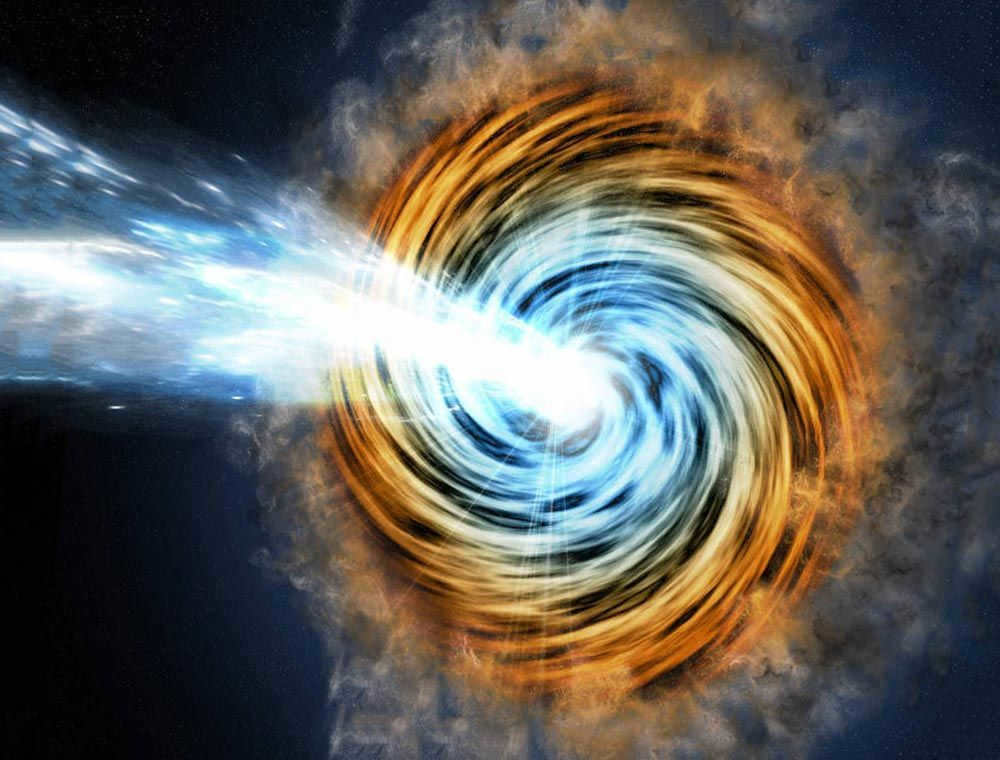
Blazars are a type of extragalactic entities with high luminosity that emit strong electromagnetic radiation across all wavelengths. These cosmic objects are known for their immense power and are of great interest to astronomers studying extragalactic phenomena. One of the distinguishing features of blazars is their rapid and substantial fluctuations in brightness, which can occur within a matter of days or even hours. Explore the appearance of blazars and impress your friends with our exclusive Blazars t-shirt. Stand out even in the vastness of outer space!
What sets a quasar apart from a blazar?
One key distinction between these two phenomena lies in the orientation of their relativistic jets. If the jet is slightly tilted towards our line of sight, it is classified as a quasar. On the other hand, if the jet is directly pointed towards us, it is known as a blazar.
A blazar’s jet must be oriented within 20 degrees towards Earth. Essentially, a blazar is just a quasar that happens to have its jet aligned with our line of sight.
Scientists may have finally unraveled the mystery surrounding the nature of quasars that has puzzled them for the past 60 years. The latest study by “Hitech” reveals the key findings.
Discover “Hitech” on
The findings indicate that in a few billion years, when the Milky Way collides with the neighboring Andromeda galaxy, it will possess its own quasar.
What exactly are quasars?
Quasars are a type of astronomical entities that are acknowledged as some of the most luminous in the observable Universe. The term quasar originates from the English words quasi-stellar and radio source, which essentially translates to “star-like radio source”.
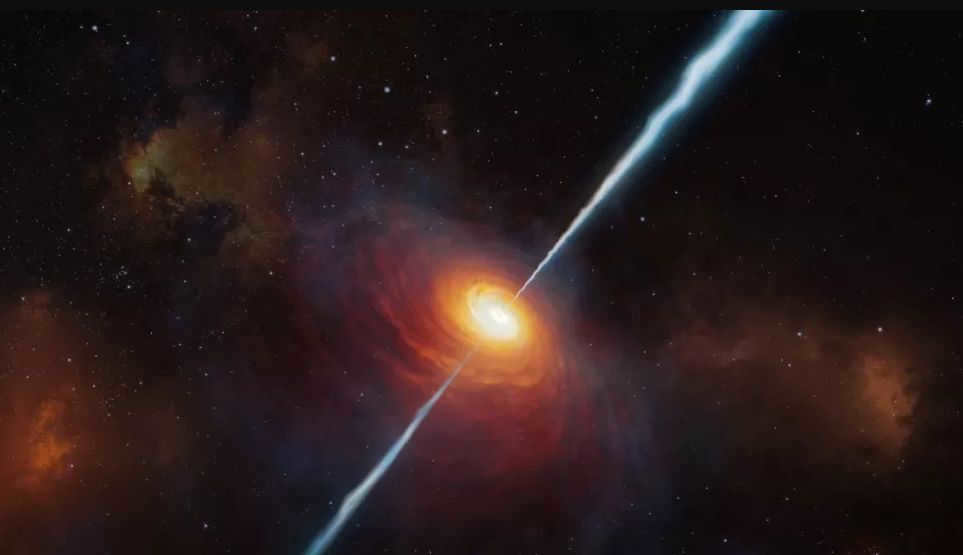
Regarding the prefix “radio”: quasars are known for their powerful radio emissions. Moreover, these celestial objects exhibit exceptional luminosity. The reason behind their brilliance is the tremendous energy they emit, which is capable of providing electricity to the Earth for several million years. It is theorized that their intense luminosity is a result of the black hole, an essential component for the existence of quasars, absorbing vast amounts of matter, including stars. These captivating entities reside at the cores of galaxies.
Furthermore, the extraordinary brightness of quasars allows astronomers to employ them as guiding lights. Their visibility from vast distances enables the exploration of distant galaxies, which remain largely unexplored by modern scientists.
Scientists have been puzzled by quasars since their discovery almost 60 years ago, primarily because they are unsure how supermassive black holes can attract enough raw material to generate such intense energy emissions. While most galaxies have supermassive black holes (SMBHs) at their centers, the gas required to fuel quasars is typically located on the outer edges.

Therefore, there must exist some kind of “transportation service” that transports the gas to the center.
What information have scientists gathered?
The scientists put forth a theory that the necessary inward movement of matter towards a quasar is a result of collisions between galaxies, whose gravitational forces can divert the gas from its usual circular paths. And they needed to verify that theory. To understand the workings of the galactic “transportation system,” the researchers utilized in-depth images captured by the Isaac Newton Telescope located in the Canary Islands, Spain.
Researchers conducted a comparison of 48 galaxies in close proximity that possess quasars, and 100 galaxies that do not. The findings revealed distorted formations at the periphery of galaxies containing quasars. Scientists hypothesize that these formations indicate a previous or ongoing collision and merger with another galaxy, as depicted in the accompanying image. Ultimately, this collision prompts a surge of star production at the core of the formation, providing the necessary fuel for the black hole.
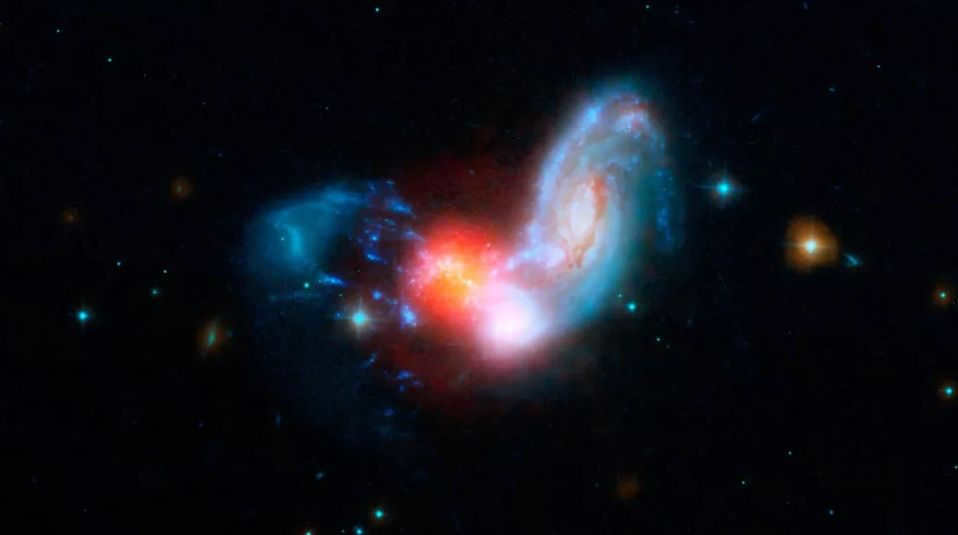
In general, this research is not the initial occasion when quasars have been connected to galaxy mergers. Nonetheless, previous efforts to verify this theory by looking for deformed formations in the outer regions of galaxies, which are indicative of such collisions, were not notably fruitful: the findings were inconclusive. Researchers suspect that the issue was due to the images not being sufficiently comprehensive and intricate.
Astronomical experts maintain the viewpoint that quasars exert a significant influence on the development of the galaxies in which they reside. Enhancing comprehension of their “ignition” process will aid scientists in refining their models of galactic evolution and the universe as a whole.
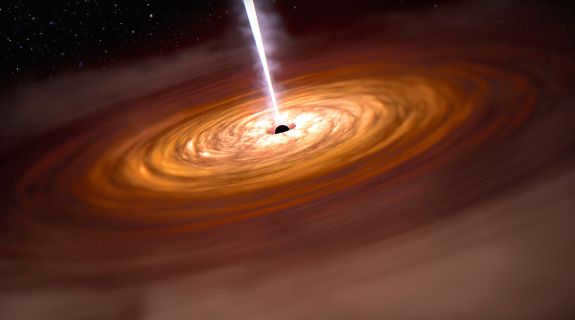
Therefore, once activated, the immense radiation emitted by a quasar has a highly detrimental impact on its neighboring host galaxy. As an illustration, the radiation pressure can expel the remaining gas, which is crucial for the birth of new stars. As a result, this would effectively halt any star formation activity, leading to its demise.
The future of our galaxy, the Milky Way
Furthermore, comprehending the correlation between galactic collisions and quasars is crucial in predicting what lies ahead for the Milky Way. Andromeda, the closest major galaxy to us, is approaching us at a rapid pace and is expected to collide and merge with our galaxy in approximately 4-5 billion years. This collision is likely to give rise to a new quasar as the gas descends into the core of the resulting system.

